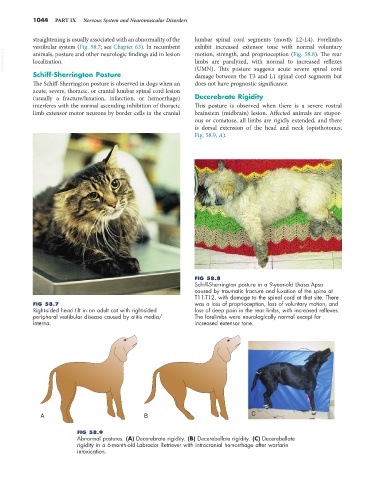Page 1072 - Small Animal Internal Medicine, 6th Edition
P. 1072
1044 PART IX Nervous System and Neuromuscular Disorders
straightening is usually associated with an abnormality of the lumbar spinal cord segments (mostly L2-L4). Forelimbs
vestibular system (Fig. 58.7; see Chapter 63). In recumbent exhibit increased extensor tone with normal voluntary
VetBooks.ir animals, posture and other neurologic findings aid in lesion motion, strength, and proprioception (Fig. 58.8). The rear
limbs are paralyzed, with normal to increased reflexes
localization.
Schiff-Sherrington Posture (UMN). This posture suggests acute severe spinal cord
damage between the T3 and L1 spinal cord segments but
The Schiff-Sherrington posture is observed in dogs when an does not have prognostic significance.
acute, severe, thoracic, or cranial lumbar spinal cord lesion
(usually a fracture/luxation, infarction, or hemorrhage) Decerebrate Rigidity
interferes with the normal ascending inhibition of thoracic This posture is observed when there is a severe rostral
limb extensor motor neurons by border cells in the cranial brainstem (midbrain) lesion. Affected animals are stupor-
ous or comatose, all limbs are rigidly extended, and there
is dorsal extension of the head and neck (opisthotonus;
Fig. 58.9, A).
FIG 58.8
Schiff-Sherrington posture in a 9-year-old Lhasa Apso
caused by traumatic fracture and luxation of the spine at
T11-T12, with damage to the spinal cord at that site. There
FIG 58.7 was a loss of proprioception, loss of voluntary motion, and
Right-sided head tilt in an adult cat with right-sided loss of deep pain in the rear limbs, with increased reflexes.
peripheral vestibular disease caused by otitis media/ The forelimbs were neurologically normal except for
interna. increased extensor tone.
A B C
FIG 58.9
Abnormal postures. (A) Decerebrate rigidity. (B) Decerebellate rigidity. (C) Decerebellate
rigidity in a 6-month-old Labrador Retriever with intracranial hemorrhage after warfarin
intoxication.

